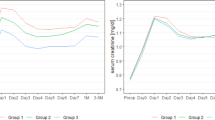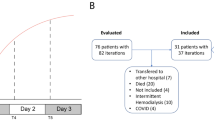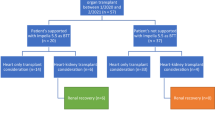Abstract
Background
We aimed to compare renal function after kidney transplantation in children who were treated with higher vs. lower fluid volumes.
Methods
A retrospective analysis of 81 living-donor renal transplantation pediatric patients was performed between the years 2007 and 2018. We analyzed associations of the decrease in serum creatinine (delta creatinine) with fluid balance, central venous pressure (CVP), pulmonary congestion, mean arterial pressure (MAP), and MAP-CVP percentiles in the first 3 postoperative days. After correcting creatinine for fluid overload, we also assessed associations of these variables with the above parameters. Finally, we evaluated the association between delta creatinine and estimated glomerular filtration rate (eGFR) at 3 months follow-up.
Results
Both delta creatinine and delta-corrected creatinine were found to be associated with pulmonary congestion on the second and third postoperative days (p < 0.02). In addition, trends for positive correlations were found of delta creatinine with fluid balance/kg (p = 0.07), and of delta-corrected creatinine with fluid balance/kg and CVP (p = 0.06–0.07) on the second postoperative day. An association was also demonstrated between the accumulated fluid balance of the first 2 days and eGFR at 3 months after transplantation (p = 0.03).
Conclusions
An association was demonstrated between indices of fluid overload, >80 ml/kg, and greater improvement in renal function.
Impact
-
There is no consensus regarding the optimal fluid treatment after pediatric renal transplantation.
-
In our cohort, indices of fluid overload were associated with better renal function immediately after the transplantation and 3 months thereafter.
-
Fluid overload after living-donor renal transplantation in children may have short- and long-term benefits on renal function.
Similar content being viewed by others
Log in or create a free account to read this content
Gain free access to this article, as well as selected content from this journal and more on nature.com
or
References
Chua, A. et al. Kidney transplant practice patterns and outcome benchmarks over 30 years: the 2018 report of the NAPRTCS. Pediatr. Transplant. 23, e13597 (2019).
Mumford, L. et al. The impact of changing practice on improved outcomes of paediatric renal transplantation in the United Kingdom: a 25 years review. Transplant. Int. 32, 751–761 (2019).
Dharnidharka, V. R., Fiorina, P. & Harmon, W. E. Kidney transplantation in children. N. Engl. J. Med. 371, 549–558 (2014).
Chiodini, B. et al. Outcomes of kidney transplantations in children weighing 15 kilograms or less: a retrospective cohort study. Transplant. Int. 31, 720–728 (2018).
Friedersdorff, F. et al. Long-term follow-up after paediatric kidney transplantation and influence factors on graft survival: a single-centre experience of 16 years. Urol. Int. 100, 317–321 (2018).
Panek, R., Tennankore, K. K. & Kiberd, B. A. Incidence, etiology, and significance of acute kidney injury in the early post-kidney transplant period. Clin. Transplant. 30, 66–70 (2016).
Halloran, P. F. & Hunsicker, L. G. Delayed graft function: state of the art, November 10-11, 2000. Summit meeting, Scottsdale, Arizona, USA. Am. J. Transplant. 1, 115–20 (2001).
Yarlagadda, S. G. et al. Association between delayed graft function and allograft and patient survival: a systematic review and meta-analysis. Nephrol. Dial. Transplant. 24, 1039–1047 (2009).
Gingell-Littlejohn, M. et al. Below-target postoperative arterial blood pressure but not central venous pressure is associated with delayed graft function. Transplant. Proc. 45, 46–50 (2013).
Schnuelle, P. & van der Woude, F. J. Perioperative fluid management in renal transplantation: a narrative review of the literature. Transplant. Int. 19, 947–959 (2006).
Adams, P. L. et al. Impaired renal blood flow autoregulation in ischemic acute renal failure. Kidney Int. 18, 68 (1980).
Conger, J. D., Robinette, J. B. & Schrier, R. W. Smooth muscle calcium and endothelium derived relaxing factor in the abnormal vascular responses of acute renal failure. J. Clin. Invest. 82, 532 (1988).
Bacchi, G. et al. The influence of intraoperative central venous pressure on delayed graft functioning in renal transplantation: a single center experience. Transplant. Proc. 42, 3387–3391 (2010).
Carlier, M. et al. Maximal hydration during anesthesia increase pulmonary arterial pressures and improves early function of human renal transplants. Transplantation 34, 201 (1982).
Gingell-Littlejohn, M. et al. Below-target postoperative arterial blood pressure but not central venous pressure is associated with delayed graft function. Transplant. Proc. 45, 46–50 (2013).
Campos, L. et al. Do intraoperative hemodynamic factors of the recipient influence renal graft function? Transplant. Proc. 44, 1800–1803 (2012).
Pape, L. et al. A single center clinical experience in intensive care management of 104 pediatric renal transplantations between 1998 and 2002. Pediatr. Transplant. 8, 39–43 (2004).
Torricelli, F. C. et al. Current management issues of immediate postoperative care in pediatric kidney transplantation. Clinics 69(Suppl. 1), 39–41 (2014).
Wang, N. et al. Beijing Acute Kidney Injury Trial (BAKIT) Workgroup. Fluid balance and mortality in critically ill patients with acute kidney injury: a multicenter prospective epidemiological study. Crit. Care 19, 371 (2015).
Acheampong, A. & Vincent, J. L. A positive fluid balance is an independent prognostic factor in patients with sepsis. Crit. Care 19, 251 (2015).
Haque, I. U. & Zaritsky, A. L. Analysis of the evidence for the lower limit of systolic and mean arterial pressure in children. Pediatr. Crit. Care Med. 8, 138–144 (2007).
Calixto Fernandes, M. H. et al. Perioperative management in kidney transplantation: a black box. Crit. Care 22, 14 (2018).
Schwartz, G. J. et al. New equations to estimate GFR in children with CKD. J. Am. Soc. Nephrol. 20, 629–637 (2009).
Basu, R. K. et al. Acute creatinine injury based on corrected serum creatinine is associated with increased morbidity in children following the arterial switch operation. Pediatr. Crit. Care Med. 14, e218–e224 (2013).
Davis, A. L. et al. American College of Critical Care Medicine clinical practice parameters for hemodynamic support of pediatric and neonatal septic shock. Crit. Care Med. 45, 1061–1083 (2017).
Hariharan, S. et al. Post-transplant renal function in the first year predicts long-term kidney transplant survival. Kidney Int. 62, 311–318 (2002).
Nieuwenhuijs-Moeke, G. J. et al. Intraoperative fluid restriction is associated with functional delayed graft function in living donor kidney transplantation: a retrospective cohort analysis. J. Clin. Med. 8, E1587 (2019).
Acknowledgements
We thank Mrs. Pnina Lilos for the statistical analysis and Ms. Cindy Cohen for the editorial work.
Author information
Authors and Affiliations
Contributions
H.P.-F. designed the data collection instruments, collected data, and drafted the initial manuscript. M.D. conceptualized and designed the study and reviewed and revised the manuscript. E.N. reviewed and revised the manuscript for important intellectual content. A.W. and E.K. collected data and reviewed and revised the manuscript for important intellectual content. G.K. conceptualized and designed the study, coordinated and supervised data collection, carried out the initial analysis, and reviewed and revised the manuscript. All authors approved the final manuscript as submitted and agree to be accountable for all aspects of the work.
Corresponding author
Ethics declarations
Competing interests
The authors declare no competing interests.
Additional information
Publisher’s note Springer Nature remains neutral with regard to jurisdictional claims in published maps and institutional affiliations.
Rights and permissions
About this article
Cite this article
Porn-Feldman, H., Davidovits, M., Nahum, E. et al. Fluid overload and renal function in children after living-donor renal transplantation: a single-center retrospective analysis. Pediatr Res 90, 625–631 (2021). https://doi.org/10.1038/s41390-020-01330-4
Received:
Revised:
Accepted:
Published:
Issue date:
DOI: https://doi.org/10.1038/s41390-020-01330-4
This article is cited by
-
Effect of perioperative management on early graft function in living donor paediatric kidney transplantation
Pediatric Nephrology (2025)
-
Changes in graft function after living donor kidney transplantation in children
Pediatric Nephrology (2023)
-
Perioperative fluid management and associated complications in children receiving kidney transplants in the UK
Pediatric Nephrology (2023)



